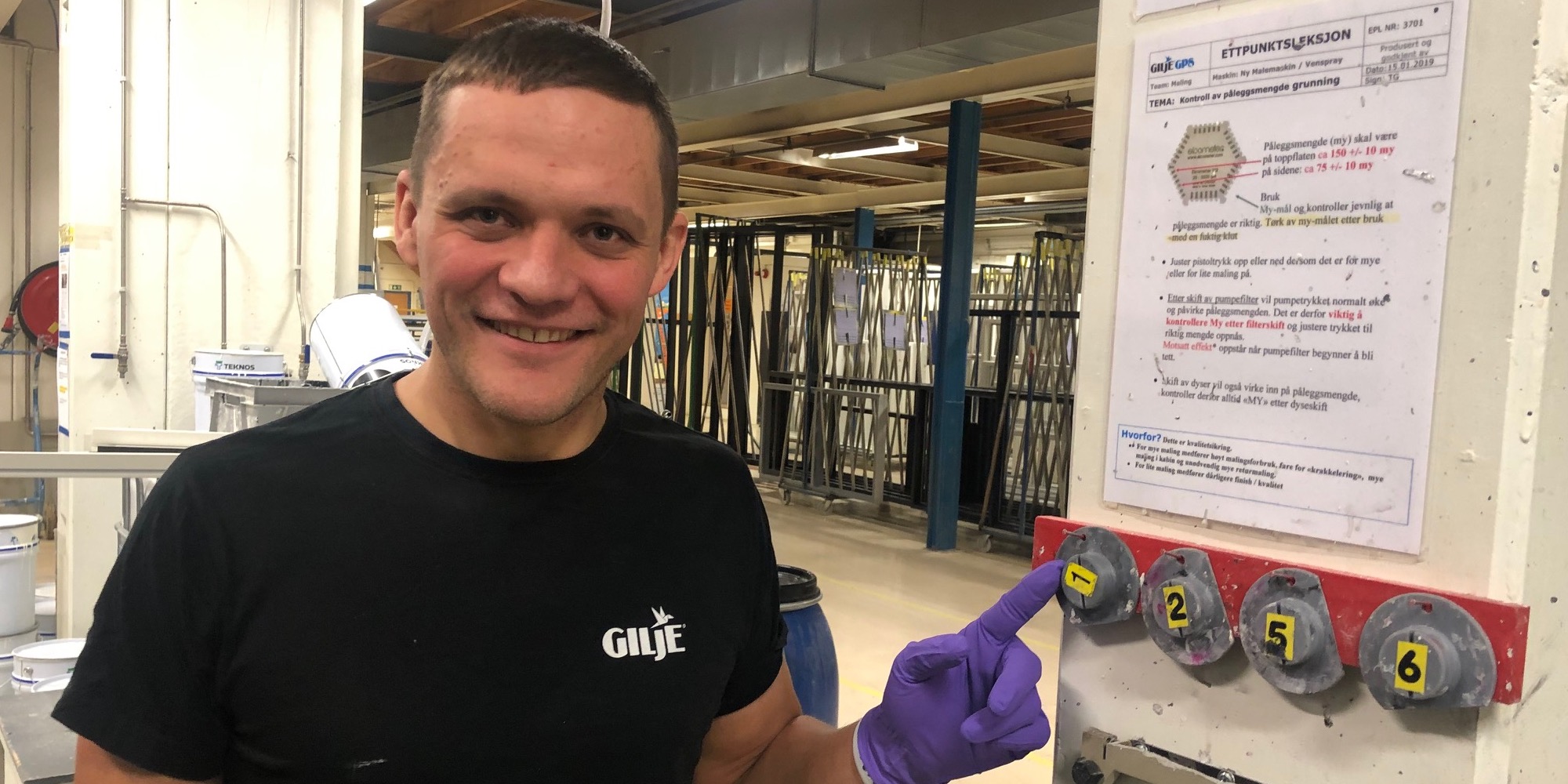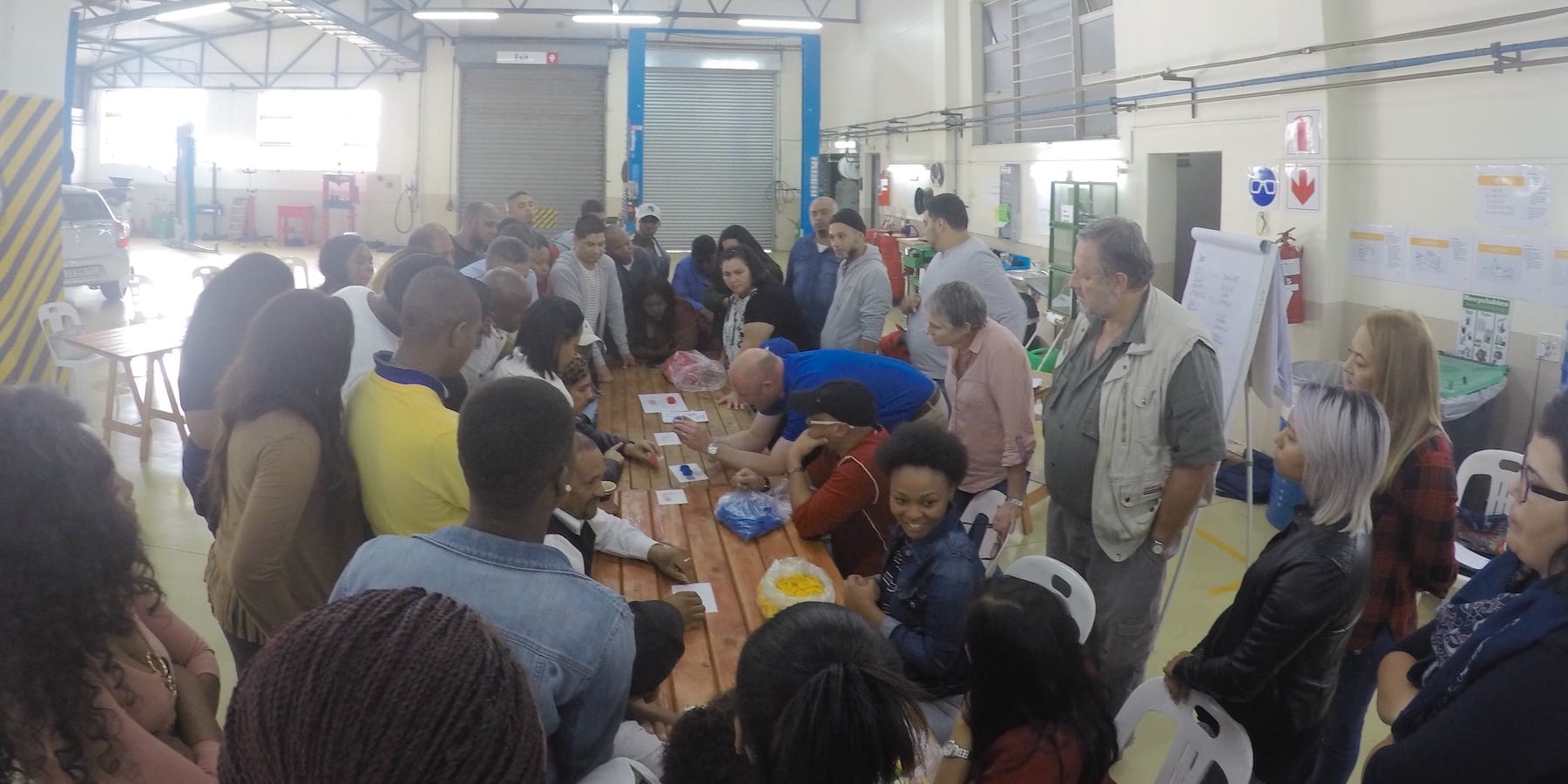
Half the bad, double the good
CASE STUDY – The story of this Norwegian window and door manufacturer shows how a deep and ongoing commitment to a lean transformation can help a company thrive against all odds.
Words: Eivind Reke, Lean Author and Organizational Secretary of Los Norge and Kenneth Gilje, Chief Culture Officer at Gilje Tre.
Manufacturing in Norway is like the bumblebee. It shouldn´t fly, but it does. The modern financial manager will have a look at the salary level of Norwegian operators and say: “No thanks, too expensive.” However, we have a long tradition of self-organization, worker participation (companies over a certain size by law have employee representatives on the board of directors) and “flat” organizational structures (the worker to CEO salary ration in a typical SME is about 2x – 4x). Add Lean Thinking, and you find companies that compete in the European market with high-quality design, flexible production processes and highly skilled workers.
About 50 kilometres from Stavanger, in the small village of Gilja, Gilje Tre is a prime example of a “bumblebee” manufacturing company. From their factories in Gilja and Moi, Gilje Tre produces windows and doors in any shape, size, form or colour to satisfy the particular wishes of any customer.
A traditional Norwegian cornerstone company, Gilje Tre is a family owned and run business, founded by the five brothers Gilje back in 1948. In Gilja, the company manufactures 110,000 unique windows, balcony doors and sliding doors in the same flow. There are 255 employees and the joke goes that half of them are named Gilje (in reality, the number is closer to 25%).
From the 1960s to the early 2000s, the market for doors and windows in Norway was one of few variations in product type, standard windows in standard sizes. The production processes of the manufacturers forced customers to buy what was available, and customers in turn viewed windows solely from the perspective of functionality. Then the market shifted: today, windows and doors are an integral part of the architecture and interior design of a home. Customers demand windows and doors that are bespoke to their house, and with new production technology design options are endless. Faced with the pressure of market evolution, Gilje Tre look to Lean Thinking to respond to customer demand with mass customization.
THE LEAN JOURNEY BEGINS
In 2000, consultant Petter Aamot came knocking on Gilje Tre’s door. After selling his shares in an IT company he co-founded, Petter had discovered TPS while travelling the world in the 1980s looking for manufacturing companies in need of IT solutions. He turned up at Gilje Tre in leather pants and jacket – a rather unorthodox outfit for a consultant – with one question: “Do you need any help?” As a matter of fact, they did. Over the six years during which Petter supported Gilje Tre, he introduced them to concepts and tools like flow, lead-time, U-cells, 5S, and so on. With his help, the company started their journey from mass-production to mass-customization.
The first major changes they made were:
- Going from build-to-warehouse to build-to-order;
- Teaming up people to enable operators to contribute to the improvement work, challenging the teams to come up with their own standards for quality control, maintenance, machine and assembly operations (over 21,500 improvements, big and small, have been carried out at Gilje Tre over the past 12 years);
- Investing in two machining lines that could produce all types of wooden frames and sashes, in any sequence, without changeovers. Such a machining line didn´t exist. It had to be developed, designed and built by their small in-house team in charge of IT & Technology. Once fully implemented, the new machining line reduced the lead-time by 40%.
Three guiding principles were born out of these changes: 1) we only build what the customer wants, when he wants it built; 2) we build people through continuous improvement; and 3) we only invest in new technology if it creates a better flow.
Improvement by improvement, the lead-time in production went down from 15 days in 1999 to 8 days in 2010 and to 3.5 days in 2018 – a 77% reduction. The management team at Gilje could have been happy with that and moved on to the next program. Instead, they realized that Lean Thinking was challenging them to go even further.
NEW FLOW 2021
The outside pressure of competition, technology, customers and regulations means that to stay competitive one needs to improve the system forever. Gilje Tre’s hoshin from 2018 (dubbed “Flow 2021”) includes a 6,000 square meter space reduction and a lead-time of six hours. To get there, the management team knew they needed to look at, and possibly change, the full layout and each major process steps in production. They knew these changes would have unforeseen consequences. However, confident in the capabilities they had developed in its people over the last 15 years, the company knew it could make it happen.
In October 2019, CEO Karles Gilje and the rest of the management team were deeply engaged in the transformation. Their learning journey was guided by the conditions of basic stability, just-in-time and jidoka and the leadership principles of “go and see, ask why, and show respect”, and inspired by Arnold Schwarzenegger’s motto “Never have a plan B!”. A sense of urgency is emerging throughout the organization: they know that creating continuous flow between previously disconnected process will unearth problems that are unknown to them, and that there will be doubts. But there is no turning back now.
Gilje Tre takes its role in the community very seriously and has therefore never considered offshoring production to low-cost countries for short-term gains. So, whenever anyone gets cold feet or starts to consider rolling back the changes, the Arnold spirit keeps them on the straight and narrow. There is no plan B!
To turn an ambitious vision into reality, Gilje Tre has begun to connect the processes of cutting and coating into continuous single-piece-flow and moved the painting upstream, closer to the previous process (something that was especially challenging for the team responsible for coating). Finding themselves in a new physical location, with a process now directly connected to the previous and with new machines, the team looked to lean tools to solve their problems one by one.
The first step was to create a visual maintenance plan for the new machines to achieve stability. Then, they started discussing what would be the best way to carry out the manual work in the process and settled on a new Standard Operating Procedure.
As the process began to stabilize, they discovered that they had problems with variation in the coating mix. A root cause analysis exercise found that the mix set-up was not intuitive. As a countermeasure, they created a visual quality standard in the form of an A4 paper. After some testing, however, a better method was discovered that would make the mixing set-up fool-proof – a simple and brilliant poka-yoke device, four cut-out plastic cases (you can see them in the main article picture) to check that the settings are correct each time they run the coating process. Finally, they updated the visual standard and the SOP to include the poka-yoke device. The process is now Kenneth-proof (all poka-yoke ideas are jokingly called Kenneth-proofing – in reference to one of the authors of this article, who is a senior manager at Gilje – “If Kenneth can do it, anyone can do it”). Back in June, they were producing with 1,400 units per/day, whereas now they are operating at 2,300 units per day. With the help of their Kenneth-proofing, their changeover time was reduced from 14 to 3 minutes.
Already in-process stock is drastically reduced in this part of the production process (it was halved over the last year). The management team is getting confirmation of one of their starting hypotheses: operators have deep knowledge of the lean tools they need and are creating new Standard Operating Procedures, new quality standards, poka-yoke devices, new maintenance instructions without having to be told to do so. They recognize the need and the benefit themselves. In the process, the operators and managers at Gilje Tre are developing deeper knowledge about their own work environment.
Karles Gilje, flow manager Per Morten Gilje and the rest of the management team (now nicknamed the Flow Team) are practicing lean leadership every day by finding and facing problems together with the operators, by challenging and supporting them in forming solutions, thus allowing them to take responsibility of their work areas. This has been a paradigm shift in management, from telling to asking why and growing the business by developing people. It was also a bit of a culture shock for everyone at Gilje Tre. The result is the achievement of a stable process quicker than was originally intended, even though the team has found and solved many more problems than they expected to encounter.
The pressure of the new process is even forcing Gilje Tre to think seriously about takt-time. Their thinking was previously “every product is different in size and shape, so we cannot work to takt-time”; and instead, they solved the problem of variation by seamlessly changing the hand-over point between the operators on the single-flow lines, and with large buffers of in-process stock between stations. With the buffers of in-process stock heavily reduced, they are forcing a radical re-think on how the teams deal with variation. Again, the conditions of TPS are challenging the people at Gilje Tre to think differently about their own work, and to look deeper into the process to find solutions to problems that were previously considered unsolvable.
To support the transformation and better reflect the actual value creation system, the organization is also changing. Gilje Tre is teaming up people around the flow, not in individual departments, and developing a support structure of technical personnel, quality engineers, sourcing, production data and so forth. They have created a quick-response andon system with team leaders responsible for improvement work and line support, and with support functions operating as servants to the value chain instead of siloed departments.
Gilje Tre is now in the middle of their second transformation. Not because they failed at the first one, but because they realized that the true promise of Lean Thinking – half the bad, double the good (the first of the three strategic intents from The Lean Strategy) – could be realized again and again. The lessons from Gilje Tre are profound but simple: are you serious as a company? Do you want to win? Do you have a clear theory on how you will win? For Gilje Tre, it all comes down to being serious about their lean efforts. When they say “Go see, ask why, show respect”, they mean it. When they put pressure on the process to develop their people, they really do it. There is no plan B!
THE AUTHORS

Read more


FEATURE – The principal of the Halfway Ottery dealership explains how their lean culture based on respect and improvement is not only changing the business, but transforming the lives of people in the townships.


CASE STUDY - The Italian branch of Tokheim services about 3,000 gas stations in the central and northern parts of Italy. The general manager shares the story of how lean thinking changed everything, for the better.


FEATURE – How do kamishibai boards work and what sort of benefits can they bring to a lean transformation? The author discusses what he saw on a recent gemba walk.


FEATURE – A real understanding of Lean Thinking can only stem from an exploration of its tacit aspects, not just its most explicit, easy-to-grasp elements.

